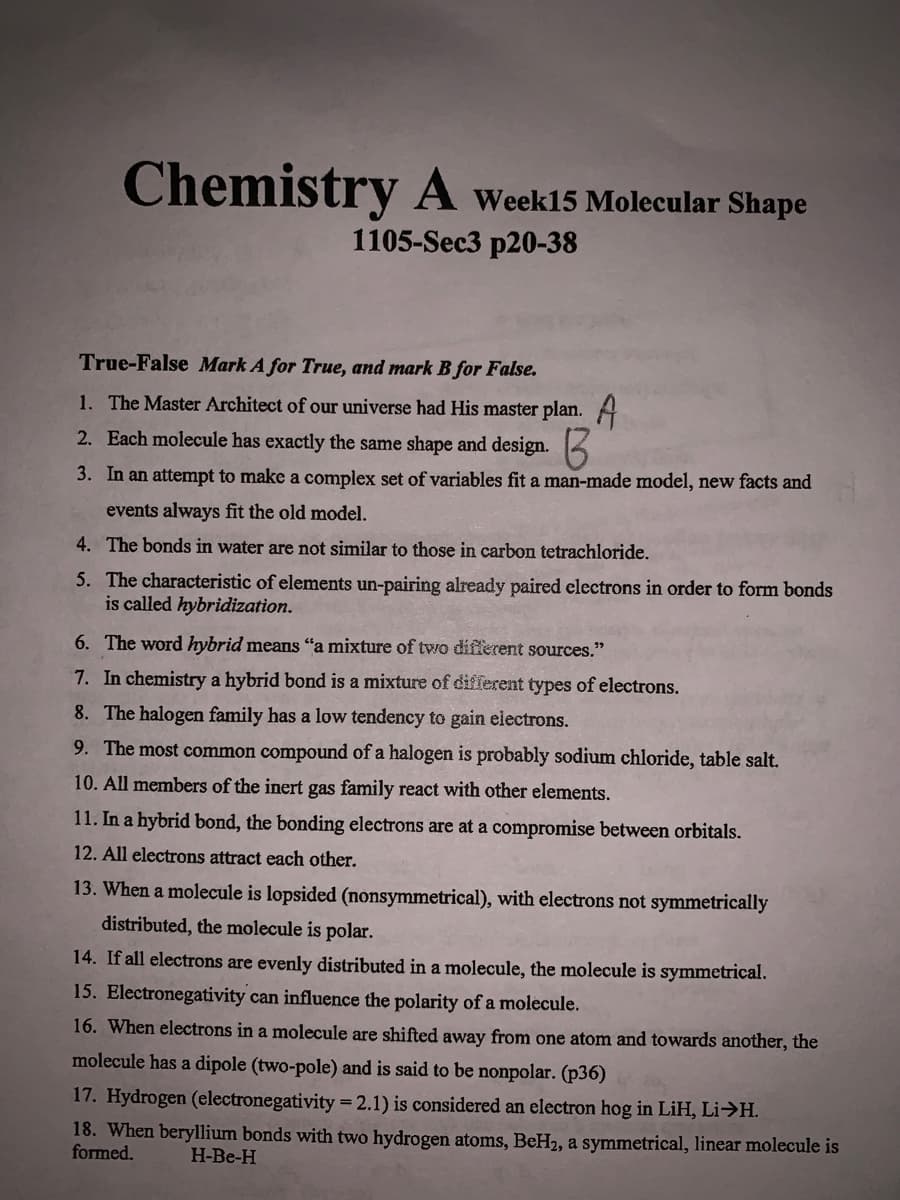mmetrical. 15. Electronegativity can influence the polarity of a molecule. 16. When electrons in a molecule are shifted away from one atom and towards another, the molecule has a dipole (two-pole) and is said to be nonpolar. (p36) 17. Hydrogen (electronegativity = 2.1) is considered an electron hog in LiH, LI→H. 18. When beryllium bonds with two hydrogen atoms, BeH2, a symmetrical, linear molecule is formed. H-Be-H
mmetrical. 15. Electronegativity can influence the polarity of a molecule. 16. When electrons in a molecule are shifted away from one atom and towards another, the molecule has a dipole (two-pole) and is said to be nonpolar. (p36) 17. Hydrogen (electronegativity = 2.1) is considered an electron hog in LiH, LI→H. 18. When beryllium bonds with two hydrogen atoms, BeH2, a symmetrical, linear molecule is formed. H-Be-H
Chemistry by OpenStax (2015-05-04)
1st Edition
ISBN:9781938168390
Author:Klaus Theopold, Richard H Langley, Paul Flowers, William R. Robinson, Mark Blaser
Publisher:Klaus Theopold, Richard H Langley, Paul Flowers, William R. Robinson, Mark Blaser
Chapter7: Chemical Bonding And Molecular Geometry
Section: Chapter Questions
Problem 114E: Use the Molecule Shape simulator (http://openstaxcollege.org/I/6MolecShape) to build a molecule....
Related questions
Question
15,16,17,18

Transcribed Image Text:Chemistry A Week15 Molecular Shape
1105-Sec3 p20-38
True-False Mark A for True, and mark B for False.
1. The Master Architect of our universe had His master plan. A
2. Each molecule has exactly the same shape and design.
3. In an attempt to make a complex set of variables fit a man-made model, new facts and
events always fit the old model.
4. The bonds in water are not similar to those in carbon tetrachloride.
5. The characteristic of elements un-pairing already paired electrons in order to form bonds
is called hybridization.
6. The word hybrid means "a mixture of two different sources."
7. In chemistry a hybrid bond is a mixture of different types of electrons.
8. The halogen family has a low tendency to gain electrons.
9. The most common compound of a halogen is probably sodium chloride, table salt.
10. All members of the inert gas family react with other elements.
11. In a hybrid bond, the bonding electrons are at a compromise between orbitals.
12. All electrons attract each other.
13. When a molecule is lopsided (nonsymmetrical), with electrons not symmetrically
distributed, the molecule is polar.
14. If all electrons are evenly distributed in a molecule, the molecule is symmetrical.
15. Electronegativity can influence the polarity of a molecule.
16. When electrons in a molecule are shifted away from one atom and towards another, the
molecule has a dipole (two-pole) and is said to be nonpolar. (p36)
17. Hydrogen (electronegativity =2.1) is considered an electron hog in LiH, Li>H.
18. When beryllium bonds with two hydrogen atoms, BeH2, a symmetrical, linear molecule is
formed.
H-Be-H
Expert Solution
This question has been solved!
Explore an expertly crafted, step-by-step solution for a thorough understanding of key concepts.
Step by step
Solved in 2 steps

Knowledge Booster
Learn more about
Need a deep-dive on the concept behind this application? Look no further. Learn more about this topic, chemistry and related others by exploring similar questions and additional content below.Recommended textbooks for you

Chemistry by OpenStax (2015-05-04)
Chemistry
ISBN:
9781938168390
Author:
Klaus Theopold, Richard H Langley, Paul Flowers, William R. Robinson, Mark Blaser
Publisher:
OpenStax

Introductory Chemistry: A Foundation
Chemistry
ISBN:
9781337399425
Author:
Steven S. Zumdahl, Donald J. DeCoste
Publisher:
Cengage Learning

Introductory Chemistry: A Foundation
Chemistry
ISBN:
9781285199030
Author:
Steven S. Zumdahl, Donald J. DeCoste
Publisher:
Cengage Learning

Chemistry by OpenStax (2015-05-04)
Chemistry
ISBN:
9781938168390
Author:
Klaus Theopold, Richard H Langley, Paul Flowers, William R. Robinson, Mark Blaser
Publisher:
OpenStax

Introductory Chemistry: A Foundation
Chemistry
ISBN:
9781337399425
Author:
Steven S. Zumdahl, Donald J. DeCoste
Publisher:
Cengage Learning

Introductory Chemistry: A Foundation
Chemistry
ISBN:
9781285199030
Author:
Steven S. Zumdahl, Donald J. DeCoste
Publisher:
Cengage Learning

Chemistry: The Molecular Science
Chemistry
ISBN:
9781285199047
Author:
John W. Moore, Conrad L. Stanitski
Publisher:
Cengage Learning

World of Chemistry, 3rd edition
Chemistry
ISBN:
9781133109655
Author:
Steven S. Zumdahl, Susan L. Zumdahl, Donald J. DeCoste
Publisher:
Brooks / Cole / Cengage Learning
